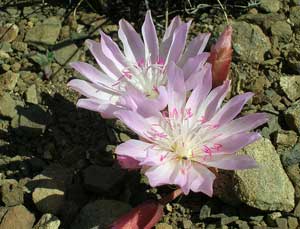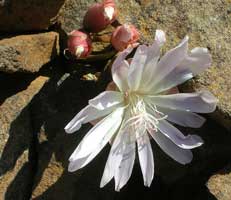The bitterroot, voted the Montana State Flower in 1894, perennially sprouts beside snow banks as winter retreats. Its whiteish-pinkish-purple petals are an iconic image of western Montana and Glacier National Park.
The bitterroot (Lewisia rediviva) grows from southern British Columbia, along the coast of California, against the Rocky Mountains of Coloraod and into the high-altitude deserts of Arizona.
Although it has a long range, only in Montana has the bitterroot grown into fame, being named for more than its state flower:
 |
|
The Bitterroot: Montana’s State Flower |
- The Bitterroot Mountains, which run-north-south and separate Idaho from Montana
- The Bitterroot Valley, brushing against the Bitterroot Mountains and covers over 100 miles
- The Bitterroot River, which runs north-south and ends in Missoula, Montana
How The Bitterroot Became the Montana State Flower
In 1893, Mary Long Alderson created a Montana Floral Emblem Society. Under its supervision, Montanans voted on their favorite flower. With more than 30 flowers receiving votes, the bitterroot received the most by over 2,500 votes.
On February 27, 1895, the Montana State Legislature named the bitterroot as its state flower.
Montana State Flower History
Although the bitterroot derives its Latin name from Meriwether Lewis who “discovered” it on his expedition with Clark, Native Americans, particularly the Flathead Indians who roamed the Bitterroot Valley, treasured this precious flower and used its roots for food and trade.
 |
|
Montana’s State Flower |
As winter concluded in Montana, the Flathead Indians would migrate into the mountains and dig up the bitterroot. However, the root was too bitter to eat raw (surprise, surprise!).
Instead, the root was boiled and served with meat or berries. Additionally, once cooked, the root was mendable, and was formed into patties for lightweight sustenance on hunting trips or for trade.
Interesting Bitterroot Facts
Like Montana’s citizens, the bitterroot is rugged, distinct and hardy.
- It survives in drought like conditions, appearing dried and dead, but suddenly will burst back to life, which lends itself to the second half of its Latin name, rediviva
- It grows low to the ground with large flowers relative to its size
- The bitterroot blooms from May to June
- It grows best in dry soil, amongst granite and shale, or loose gravel in high-altitude valleys or low-lying mountainsides
More Montana Fish & Wildlife Information
Montana Fish & Wildlife – Return back to information on Montana Fish and Wildlife
Return home from the Montana State Flower to the Glacier Travel Guide











Speak Your Mind